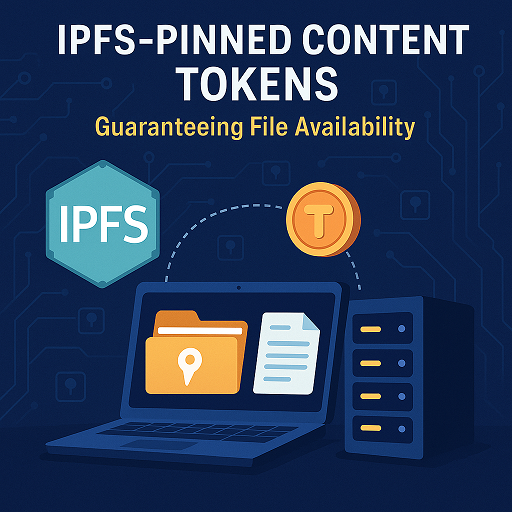In the digital age, ensuring data availability is crucial, and IPFS offers an effective solution to this challenge. From personal media to enterprise-grade datasets, ensuring that files remain accessible is a constant challenge. Conventional storage infrastructures that depend on centralized servers are exposed to risks such as censorship, downtime, and single points of failure. This is where decentralized technologies come into play, particularly through innovations like pinned content tokens that guarantee persistent file access on distributed networks.
This article explores how tokenized solutions can secure file availability, focusing on the mechanics, benefits, and real-world applications of pinned content in decentralized storage ecosystems.
The Role of IPFS in Decentralized Storage Networks
The InterPlanetary File System (IPFS) has emerged as a foundational protocol for distributed file storage. Unlike conventional systems that rely on central servers, it organizes files in a peer-to-peer network where each file is identified by its cryptographic hash. This ensures content integrity and versioning while reducing dependence on specific nodes.
However, simply uploading a file does not guarantee its availability over time. Without active nodes pinning the file, it risks being garbage-collected. To counter this, pinning services are used to ensure that specific files remain permanently hosted on the network.
Why Pinning Matters for File Availability on IPFS
In decentralized environments, there is no central authority automatically tasked with preserving file availability. Nodes voluntarily participate, but none are obligated to keep specific data accessible indefinitely. Pinning addresses this issue by instructing nodes to retain selected files indefinitely.
For businesses, artists, developers, and even decentralized application (dApp) creators, pinning becomes essential. It transforms the network from a transient storage solution into a reliable content delivery infrastructure.
Introducing IPFS-Pinned Content Tokens for Sustainable Storage
Pinned content tokens introduce a creative incentive mechanism that encourages network participants to maintain file persistence over extended periods. These tokens act as a reward system for those who allocate resources to keep content available within decentralized networks.
The concept parallels decentralized finance (DeFi) staking mechanisms but applies to storage resources. Token holders commit to pinning data, while issuers define rewards or service-level agreements (SLAs) for maintaining file access.
How Pinned Content Tokens Work in IPFS-Based Systems
The lifecycle of a pinned content token involves several key actors and processes:
- Content Issuer: An individual or organization uploads a file and issues tokens to incentivize pinning.
- Pinning Node Operator: A participant in the network who commits storage capacity and stakes tokens to continuously host the designated file, ensuring its availability to other nodes.
- Smart Contracts: Automated agreements monitor uptime, verify file availability, and distribute rewards.
- End Users: Consumers of the content who benefit from persistent access without worrying about node reliability.
By leveraging smart contracts, the entire process becomes trustless, automated, and auditable on-chain.
Economic Incentives Behind IPFS-Pinned Content Tokens
One of the primary drivers for adopting pinned content tokens is the alignment of economic incentives. Operators are rewarded for contributing storage capacity and maintaining uptime, while issuers ensure that critical files remain accessible.
This model promotes a self-sustaining ecosystem where file availability is no longer dependent on altruism or centralized services. Tokenomics can be designed to reflect factors such as:
- Duration of pinning commitments
- Geographic distribution of nodes
- File popularity and access frequency
- Redundancy levels to prevent data loss
Use Cases for Tokenized File Availability in IPFS Ecosystems
The applications of pinned content tokens span multiple industries and practical scenarios. Some notable examples include:
1. NFT Metadata Persistence
Non-fungible tokens (NFTs) often reference metadata and assets stored off-chain. Ensuring the longevity of these assets is critical to preserving NFT value. Tokenized pinning solutions can guarantee that images, videos, and metadata remain accessible even if original hosting nodes disappear.
2. Decentralized Media Platforms
Content creators seeking censorship-resistant distribution channels can utilize pinned content tokens to maintain availability of their videos, music, or articles. This fosters a more open internet where creators retain control over their work.
3. Scientific and Open Data Repositories
Academic and scientific communities often struggle with the long-term availability of datasets. Pinned content tokens provide a decentralized alternative to centralized repositories, ensuring that research data remains publicly accessible.
4. dApp Frontends and Static Sites
Decentralized applications frequently host their frontends on distributed networks. Tokenizing the availability of these assets ensures that users can reliably access the dApp interfaces, bolstering user experience and service reliability.
5. Archival and Historical Data Preservation
Pinned content tokens can also support digital preservation efforts, securing historical records, legal documents, and archival data against censorship and degradation over time.
Advantages of Using IPFS-Pinned Content Tokens
Incorporating pinned content tokens into a data persistence strategy brings forth several significant benefits:
- Decentralized Assurance: Removes dependency on centralized pinning services.
- Transparent SLAs: Smart contracts enforce availability guarantees.
- Economic Alignment: Incentivizes node operators through token rewards.
- Scalability: Facilitates global content availability through distributed participation.
- Censorship Resistance: Protects content from arbitrary takedown by centralized authorities.
Challenges and Considerations in Tokenized Pinning Models
Despite their potential, pinned content tokens face certain challenges that require thoughtful solutions:
1. Verification of Availability
Efficient and trustless mechanisms to verify that a node is actually pinning a file are essential. Cryptographic proofs or periodic audits are potential solutions but must be designed to prevent gaming the system.
2. Dynamic Network Conditions of IPFS
Network nodes may experience variable uptime, bandwidth limitations, or hardware failures. Token models need to incorporate redundancy and fallback mechanisms to maintain availability.
3. Token Inflation and Economic Sustainability
Over time, token inflation could dilute incentives for pinning. Well-designed tokenomics are crucial to maintaining long-term operator engagement without undermining value.
4. Governance and Dispute Resolution
Decentralized governance models are necessary to resolve disputes, update protocols, and adapt to evolving storage needs. DAO-based structures offer a promising path forward.
Emerging Protocols Leveraging IPFS-Pinned Content Tokens
Several projects are already experimenting with or implementing tokenized pinning solutions. While specific implementations may vary, common goals include enhancing content permanence, incentivizing node participation, and fostering a robust decentralized storage layer.
These protocols often build on top of existing decentralized storage networks, adding incentive layers and automation through smart contracts to streamline the pinning process.
Future Outlook: The Evolution of IPFS-Backed Token Ecosystems
With broader adoption, the landscape of decentralized file storage and tokenized pinning is poised to evolve in several key directions:
- Cross-Protocol Integrations: Combining storage solutions with DeFi, identity, and access control protocols.
- Enhanced Verification Tools: More sophisticated methods for content availability auditing.
- Marketplace Models: Platforms where storage providers and content issuers negotiate pinning contracts.
- Regulatory Frameworks: Guidelines ensuring compliance while preserving decentralization principles.
The long-term vision is an internet where content availability is governed by decentralized incentives, not by the whims of centralized authorities or the limitations of volunteer-driven networks.
Conclusion of IPFS: Securing the Future of File Availability
Pinned content tokens offer a practical, scalable solution to the persistent challenge of file availability in decentralized ecosystems. By leveraging economic incentives, smart contracts, and community-driven participation, they address a critical gap in current storage models.
While challenges remain, the ongoing development and refinement of tokenized pinning frameworks promise a more resilient and censorship-resistant web. For creators, developers, and organizations alike, adopting these solutions represents a strategic investment in the permanence and integrity of their digital assets.
As the technology matures, pinned content tokens will likely become a cornerstone of decentralized storage infrastructures, guaranteeing that the files of today remain accessible tomorrow and beyond.




















